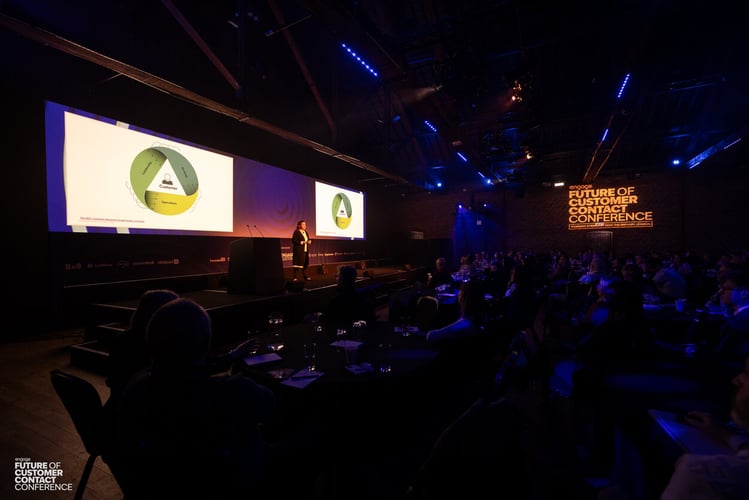The State of Customer Obsession in Europe

By Michelle Beeson, Senior Analyst at Forrester
According to the Oxford English Dictionary, an obsession is an idea or thought that continually preoccupies or intrudes on a person’s mind. Forrester uses this word deliberately, even provocatively, to drive action. It does not just mean doing everything your customer wants. Customer obsession starts with deeply understanding your customers’ needs and flows through to putting customer needs at the heart of leadership, strategy, and operations. By doing this, it enables companies to sense and respond to dynamic market conditions, powering long-term growth – something that’s been particularly crucial in recent years as businesses navigate an unstable economic environment.
Customer obsession is not something that companies do; it’s something companies are. Firms in Europe are increasingly customer obsessed – and for good reason. Global executive decision-makers at customer-obsessed companies report 1.6 times faster revenue growth, 1.7 times faster profit growth, and 1.6 times better customer retention than those at non-customer obsessed companies.
THE CUSTOMER-OBSESSED LANDSCAPE IN EUROPE
Until recently, European firms had lagged behind their global peers with regards to the customer obsession journey. Indeed, in 2023, 42% of European companies were either customer-committed or customer-obsessed, compared to just 28% in 2022. However, peak customer obsession remains a small, select group of only 6% of European firms. This isn’t necessarily a surprise given what’s required to be customer obsessed. It’s hard and is the result of a significant, years-long strategic transformation.
Funding and public status subsequently have a bigger impact on whether a company is customer-obsessed, more so than a company’s business model. Indeed, European firms with higher levels of customer obsession maturity tend to be large, publicly listed multinational companies with capital funding.
When comparing European countries, Italian firms take the lead with 8% classified as customer obsessed and 46% as customer committed. At the other end of the spectrum, UK firms lag behind with 52% customer engaged, with proportionally more firms falling into the least customer-obsessed segments, compared to their European peers.
CUSTOMER-OBSESSED FIRMS ACROSS EUROPE ARE MORE OPTIMISTIC ABOUT THE FUTURE
The benefits of being customer obsessed are significant. Leaders at European firms that are customer-obsessed are much more likely to be optimistic about their firm’s prospects than their peers at less customer-obsessed firms. It’s widely regarded that by maintaining the same customer-obsessed management approach, corporate philosophy, and innovation strategies over five or more years, firms will build and maintain stronger customer relationships. In fact, 98% of leaders at customer-obsessed firms in Europe agree that their organisation’s relationship with its customers will be stronger in five years, compared to just 24% at firms that are merely customer-aware.
Customer-obsessed firms are also known to be more profitable. European leaders at customer-obsessed firms unanimously agree that their organisation will be a top provider of its products and services. This generates high levels of optimism with 95% of customer-obsessed European leaders believing that their firm will be more profitable in five years. This is compared to 30% of European leaders at firms with lower maturity levels – specifically those that are only customer-aware – who believe it’s only likely that their firm will be more profitable in the future.
Finally, customer-obsessed firms are more likely to out-innovate their competitors. According to our research, 93% of leaders at customer-obsessed organisations in Europe believe that their strategy will help them be more innovative than other firms in their industry, compared to only 26% at customer-aware firms.
HOW TO BE CUSTOMER OBSESSED
According to Forrester, firms that create a strong emotional connection with their customers drive loyalty in the form of retention, enrichment, and advocacy. To efficiently and consistently create value for customers, and therefore drive business value, firms must understand customer needs and create empathetic customer connections.
Indeed, customer-obsessed organisations create value for their customers based on a deep understanding of – and focus on – the specific needs of the customer. Leaders at customer-obsessed firms unanimously agree that they have a strong understanding of what their customers want from them and that they prioritise customer needs when making product or process decisions.
It’s also imperative that customer-obsessed firms are empathetic. Our research shows that 93% of executives at customer-obsessed European firms describe their company as empathetic, compared to just 5% of those at customer-aware firms. It’s crucial that firms make emotional connection part of a broad strategy that involves every function in the value chain, from product development and marketing to sales and service.
Ultimately, by building strong emotional connections with customers, understanding exactly what they need and expressing empathy, European customer-obsessed businesses are much more likely to increase revenue, profitability, customer retention, and employee engagement faster than other firms.
This article was originally published in the February issue of the Engage Magazine.


